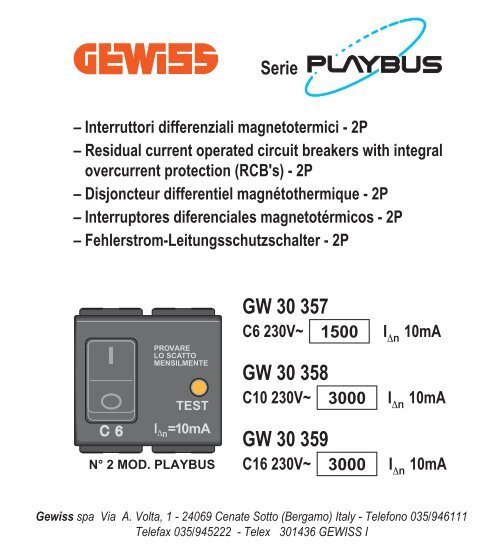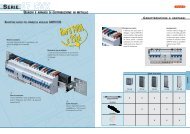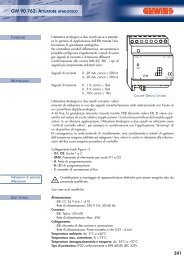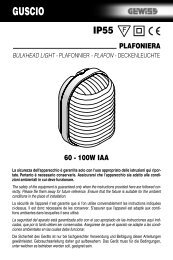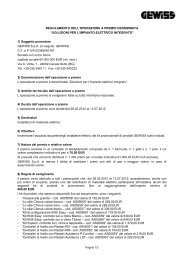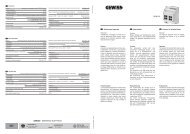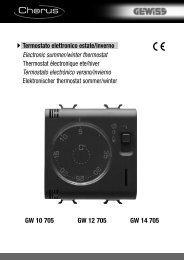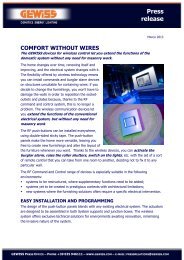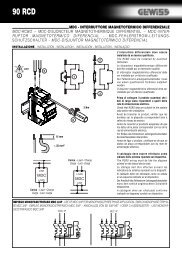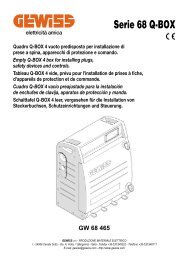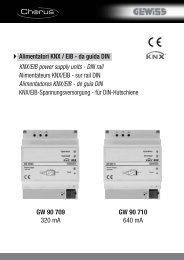GW 30 357 GW 30 358 GW 30 359 - Gewiss
GW 30 357 GW 30 358 GW 30 359 - Gewiss
GW 30 357 GW 30 358 GW 30 359 - Gewiss
You also want an ePaper? Increase the reach of your titles
YUMPU automatically turns print PDFs into web optimized ePapers that Google loves.
Serie<br />
– Interruttori differenziali magnetotermici - 2P<br />
– Residual current operated circuit breakers with integral<br />
overcurrent protection (RCB's) - 2P<br />
– Disjoncteur differentiel magnétothermique - 2P<br />
– Interruptores diferenciales magnetotérmicos - 2P<br />
– Fehlerstrom-Leitungsschutzschalter - 2P<br />
I ∆n =10mA<br />
<strong>GW</strong> <strong>30</strong> <strong>357</strong><br />
C6 2<strong>30</strong>V~ 1500<br />
PROVARE<br />
LO SCATTO<br />
<strong>GW</strong> <strong>30</strong> <strong>358</strong><br />
MENSILMENTE<br />
TEST C10 2<strong>30</strong>V~ <strong>30</strong>00<br />
N° 2 MOD. PLAYBUS<br />
<strong>GW</strong> <strong>30</strong> <strong>359</strong><br />
C16 2<strong>30</strong>V~ <strong>30</strong>00<br />
I ∆n<br />
10mA<br />
I ∆n<br />
10mA<br />
I ∆n<br />
10mA<br />
<strong>Gewiss</strong> spa Via A. Volta, 1 - 24069 Cenate Sotto (Bergamo) Italy - Telefono 035/946111<br />
Telefax 035/945222 - Telex <strong>30</strong>1436 GEWISS I
Generalità<br />
Gli interruttori differenziali (ID) magnetotermici "Serie<br />
Playbus" sono dispositivi previsti per la protezione contro le<br />
sovraccorrenti e contro i contatti indiretti in caso di guasto<br />
dell' isolamento quando le masse dell'impianto elettrico<br />
utilizzatore sono collegate a una terra idonea.<br />
Gli ID magnetotermici "Serie Playbus" con corrente<br />
differenziale di 10mA consentono di proteggere l' utente nel<br />
caso di un contatto diretto con parti in tensione non solo dal<br />
pericolo di fibrillazione cardiaca, ma anche di tetanizzazione<br />
muscolare, senza timore di scatti intempestivi, essendo<br />
destinati alla protezione di terminazioni di impianto, ove<br />
usualmente la corrente totale di dispersione dell' impianto e<br />
degli apparecchi alimentati è inferiore a 5mA. Inoltre, essi<br />
sono provvisti di protezione contro i transistori di rete e di<br />
origine atmosferica.<br />
Gli ID magnetotermici "Serie Playbus" sono classificati<br />
secondo la norma IEC 1009-1 fra quelli che dipendono dalla<br />
tensione di linea e che sono in grado di proteggere l' utente<br />
per un abbassamento della tensione di rete fino ad un<br />
minimo di 160V~ e, in accordo con la norma IEC 364-5-63,<br />
così vanno installati a valle di un interruttore differenziale che<br />
realizza la protezione anche in mancanza di neutro.<br />
Gli ID magnetotermici "Serie Playbus" sono del tipo A il cui<br />
scatto è assicurato per correnti differenziali sia alternate che<br />
pulsanti unidirezionali, per una miglior protezione dell' utente,<br />
anche in caso di alimentazione di apparecchi che impiegano<br />
circuiti elettronici quali: personal computer,registratori di<br />
cassa, bilance elettroniche, etc. ...<br />
Dati tecnici<br />
• Numero poli: bipolare con un polo protetto (2P) con neutro<br />
a destra.<br />
• Tensione nominale: 2<strong>30</strong>V~<br />
• Correnti nominali (In): 6, 10, 16A<br />
• Correnti differenziali nominali (I ∆n ): 10mA<br />
• Potere di interruzione differenziale nominale: 500A<br />
• Potere nominale di corto circuito: - per 6A: 1,5kA<br />
- per 10, 16A: 3kA<br />
• Massimo valore di (I 2 t): inferiore a 34 kA 2 s<br />
• Caratteristica magnetotermica: tipo C<br />
• Caratteristica differenziale: tipo A<br />
• Numero moduli: 2x25 mm<br />
Rispondenza normativa<br />
Gli ID magnetotermici "Serie Playbus" sono conformi alle<br />
norme:<br />
EN 60 898 (CEI 23-3, IV Ediz.)<br />
IEC 1009-1<br />
CEI 23-18. V3.<br />
Montaggio<br />
A scatto nella serie Playbus e con accessori Art. <strong>GW</strong> 32 422<br />
su profilati DIN EN 50 022.<br />
Morsetti<br />
Massima sezione dei conduttori in rame collegabili: fino a 2<br />
conduttori da 4 mm 2 .<br />
Collegamento alla rete di alimentazione<br />
Il collegamento degli ID magnetotermici "Serie Playbus" può<br />
essere effettuato indifferentemente tramite i morsetti superiori<br />
o quelli inferiori.<br />
Coordinamento dell' ID magnetotermico con l' impianto<br />
di messa a terra<br />
Per assicurare l' efficacia della protezione differenziale contro<br />
i contatti indiretti è necessario eseguire l'impianto di messa a<br />
terra secondo la norma CEI 64-8, inoltre tutti gli apparecchi<br />
utilizzatori provvisti di morsetti per la messa a terra devono<br />
essere collegati al conduttore di protezione.<br />
Segnalazione del tipo di guasto e ripristino dell'<br />
interruttore<br />
Nel caso di apertura automatica dell'interruttore in seguito ad<br />
un guasto verso terra la leva assume la posizione di aperto.<br />
Verifica del funzionamento<br />
Premere mensilmente il tasto di prova contrassegnato con la<br />
lettera "T" per verificare l'efficenza del differenziale.<br />
Premendo il tasto di prova "T", l' interruttore deve aprire.<br />
Attenzione:<br />
Lasciare a disposizione dell' utente il presente foglio di<br />
istruzioni.<br />
I prodotti del programma Playbus sono installabili<br />
conformemente a quanto previsto dalle norme CEI 64-8 per<br />
gli apparecchi per uso domestico e similare, in ambienti non<br />
polverosi ed ove non sia necessaria una protezione speciale<br />
contro la penetrazione di acqua.
General<br />
The “Playbus Series” of magnetothermal differential switches<br />
(DS) are devices to provide protection against overcurrents<br />
and against indirect contacts in the event of failure of the<br />
insulation when the earth wires of the user electric system<br />
are connected to a suitable earth.<br />
The “Playbus Series” of magnetothermal DS with a<br />
differential current of 10mA allow user protection in the event<br />
of direct contact with live parts, not only against the risk of<br />
cardiac fibrillation, but also against muscular contraction,<br />
without fear of delayed tripping, as they are intended to<br />
protect the ends of the system, where the total leakage<br />
current of the system and of the supplied appliances is less<br />
than 5mA. Moreover they are provided with protection against<br />
transient states in the mains or of atmospheric origin.<br />
The “Playbus Series” of magnetothermal DS are classified<br />
according to regulation IEC 1009-1 among those that depend<br />
on the line voltage and are able to protect the user in the<br />
event of a drop in the mains voltage up to a minimum of<br />
160V~ and, in accordance with regulation IEC 364-5-63, they<br />
are installed downstream from a differential switch which<br />
provides protection even where there is no neutral.<br />
The “Playbus Series” of magnetothermal DS are type A, the<br />
tripping of which is ensured for both alternating and<br />
unidirectional pulsing differential currents, for better user<br />
protection, even in the case of feeding appliances that use<br />
electronic circuits, such as personal computers, cash<br />
registers, electronic scales, etc. ...<br />
Technical data<br />
• Number of poles: two-pole with one protected pole (2P)<br />
with the neutral on the right.<br />
• Rated voltage: 2<strong>30</strong> V ~<br />
• Rated currents (In): 6, 10, 16A<br />
• Rated differential currents (I ∆n ): 10 mA<br />
• Rated differential break power: 500A<br />
• Rated short-circuiting power: - for 6A: 1,5 kA<br />
- for 10, 16A: 3 kA<br />
• Maximum value of (l 2 t): less than 34 kA 2 s<br />
• Magnetothermal characteristic: type C<br />
• Differential characteristic: type A<br />
• Number of modules: 2x25 mm.<br />
Compliance with regulations<br />
The “Playbus Series” of magnetothermal DS comply with the<br />
following regulations:<br />
EN 60 898 (CEI 23-3, IV Edition)<br />
IEC 1009-1<br />
CEI 23-18, V3<br />
Assembly<br />
Snap-fitting in the Playbus series and with accessories<br />
Art. <strong>GW</strong> 32 422 on DIN sections EN 50 022.<br />
Terminals<br />
Maximum cross-section of the copper leads that can be<br />
connected: up to two 4 mm 2 leads.<br />
Connection to the supply mains<br />
The “Playbus Series” of magnetothermal DS may be<br />
connected by means of either the top or the bottom terminals.<br />
Coordination of the magnetothermal DS with the earth<br />
system<br />
To ensure the efficiency of the differential protection against<br />
indirect contacts, the system must be earthed in compliance<br />
with regulation CEI 64-8 and all the user appliances with<br />
terminals for earthing must be connected to the protection<br />
lead.<br />
Indication of the type of fault and resetting of the switch<br />
In the event of the automatic switching off of the switch after<br />
a failure to earth, the lever remains in off position.<br />
Checking operation<br />
Every month, press the test button marked with letter “T” to<br />
check the efficiency of the differential.<br />
When the “T” button is pressed, the switch should switch off.<br />
Attention:<br />
This sheet of instructions should be left at the user’s disposal.<br />
The products in the Playbus range may be installed in<br />
compliance with the provisions of regulations CEI 64-8 for<br />
appliances for domestic and similar use, in non-dusty<br />
environments and where special protection is required<br />
against water penetration.
Généralités<br />
Les disjoncteurs différentiels (ID) magnétothermiques “Série<br />
Playbus” sont des dispositifs prévus pour la protection contre<br />
les surintensités et contre les contacts indirects en cas de<br />
défaut de l’isolement quand les masses de l’installation<br />
électrique utilisatrice sont correctement raccordées à la terre.<br />
Les ID magnétothermiques “Série Playbus” avec courant<br />
différentiel de 10mA permettent de protéger l’utilisateur en<br />
cas de contact direct avec des parties sous tension, non<br />
seulement contre le danger de fibrillation cardiaque, mais<br />
aussi de tétanisation musculaire, sans crainte de<br />
déclenchements intempestifs, étant donné qu’ils sont<br />
destinés à la protection des parties terminales de<br />
l’installation, où le courant total de fuite de l’installation même<br />
et des appareils alimentés est généralement inférieur à 5mA.<br />
Ils sont en outre équipés de protection contre les transistors<br />
de réseau et d’origine atmosphérique.<br />
Les ID magnétothermiques “Série Playbus” sont classés<br />
selon la norme IEC 1009-1 parmi ceux qui dépendent de la<br />
tension de ligne et qui sont à même de protéger l’utilisateur<br />
d’une baisse de la tension de réseau jusqu’à un minimum de<br />
160V~ et, en accord avec la norme IEC 364-5-63, ils sont<br />
installés en aval d’un disjoncteur différentiel qui assure la<br />
protection, même en cas de manque de neutre.<br />
Les ID magnétothermiques “Série Playbus” sont du type A,<br />
c’est-à-dire que le déclenchement est assuré pour des<br />
courants différentiels aussi bien alternatifs que pulsatoires<br />
unidirectionnels, pour mieux protéger l’utilisateur, même en<br />
cas d’alimentation d’appareils qui utilisent des circuits<br />
électroniques comme les ordinateurs individuels, les caisses<br />
enregistreuses, les balances électroniques, etc. ...<br />
Données techniques<br />
• Nombre de pôles: bipolaire avec un pôle protégé (2P) avec<br />
neutre à droite.<br />
• Tension nominale: 2<strong>30</strong>V~<br />
• Courants nominaux (In): 6, 10, 16A<br />
• Courants différentiels nominaux (I ∆n ): 10mA<br />
• Pouvoir de coupure différentiel nominal: 500A<br />
• Pouvoir nominal de court-circuit: - pour 6A: 1,5kA<br />
- pour 10, 16A: 3kA<br />
• Valeur maximum de (I 2 t): inférieure à 34 kA 2 s<br />
• Caractéristique magnétothermique: type C<br />
• Caractéristique différentielle: type A<br />
• Nombre de modules: 2x25 mm<br />
Correspondance aux normes<br />
Les ID magnétothermiques “Série Playbus” sont conformes<br />
aux normes:<br />
EN 60 898 (CEI 23-3, IV Edition)<br />
IEC 1009-1<br />
CEI 23-18. V3<br />
Montage<br />
A enclenchement dans la série Playbus et avec accessoires<br />
Art. <strong>GW</strong> 32 422 sur profilés DIN EN 50 022.<br />
Bornes<br />
Section maximum des conducteurs en cuivre raccordables:<br />
jusqu’à 2 conducteurs de 4 mm 2 .<br />
Raccordement au réseau d’alimentation<br />
Le raccordement des ID magnétothermiques “Série Playbus”<br />
peut être effectué indifféremment au moyen des bornes<br />
supérieures ou des bornes inférieures.<br />
Coordination de l’ID magnétothermique avec<br />
l’installation de mise à la terre<br />
Pour assurer l’efficacité de la protection différentielle contre<br />
les contacts indirects, il est nécessaire d’effectuer<br />
l’installation de mise à la terre selon la norme CEI 64-8; de<br />
plus, tous les appareils utilisateurs équipés de bornes pour la<br />
mise à la terre doivent être raccordés au conducteur de<br />
protection.<br />
Signalisation du type de défaut et rétablissement du<br />
disjoncteur<br />
Dans le cas d’ouverture automatique du disjoncteur à la suite<br />
d’un défaut vers la terre, le levier se met en position de<br />
“ouvert”.<br />
Contrôle du fonctionnement<br />
Une fois par mois, appuyer sur la touche d’essai portant la<br />
lettre “T” pour vérifier l’efficacité du différentiel.<br />
Quand on appuie sur cette touche "T", le disjoncteur doit<br />
s’ouvrir.<br />
Attention:<br />
Laisser la présente feuille d’instructions à la disposition de<br />
l’utilisateur.<br />
Les produits du programme Playbus peuvent être installés<br />
conformément à ce que prévoient les normes CEI 64-8 pour<br />
les appareils à usage domestiques et similaires, en milieux<br />
non poussiéreux et ne demandant pas de protection spéciale<br />
contre l’infiltration d’eau.
Descripción general<br />
Los interruptores diferenciales (ID) magnetotérmicos “Serie<br />
Playbus” son dispositivos previstos para la protección contra<br />
las sobrecorrientes y contra los contactos indirectos en<br />
presencia de averías del aislamiento, cuando las masas de<br />
la instalación eléctrica usuaria cuentan con una adecuada<br />
conexión a tierra.<br />
Los ID magnetotérmicos “Serie Playbus” con corriente<br />
diferencial de 10mA amparan al usuario en el caso de un<br />
contacto directo con partes bajo tensión, protegiéndole no<br />
sólo contra el peligro de fibrilación cardiaca, sino también<br />
contra la tetanización muscular. El usuario no deberá temer<br />
saltos intempestivos, pues estos interruptores están<br />
destinados a la protección de terminaciones de la instalación<br />
donde usualmente la corriente normal de dispersión de la<br />
instalación y de los aparatos alimentados es inferior a 5mA.<br />
Asimismo, están dotados de protección contra los<br />
transistores de red y de origen atmosférico.<br />
Los ID magnetotérmicos “Serie Playbus” están clasificados<br />
por la norma IEC 1009-1 entre aquellos que dependen de la<br />
tensión de línea y que pueden proteger al usuario para una<br />
caída de la tensión de red hasta un valor mínimo de 160V~;<br />
por lo tanto, de conformidad con la norma IEC 364-5-63,<br />
deben instalarse después de un interruptor diferencial que<br />
realice la protección aun en ausencia de neutro.<br />
Los ID magnetotérmicos “Serie Playbus” son del tipo A, cuya<br />
activación es suministrada por corrientes diferenciales tanto<br />
alternadas que intermitentes unidireccionales, para una<br />
mejor protección del usuario también en el caso de<br />
alimentación de aparatos que utilizan circuitos electrónicos,<br />
tales como: ordenadores personales, cajas registradoras,<br />
balanzas electrónicas, etc. ...<br />
Datos técnicos<br />
• Número polos: bipolar con un polo protegido (2P) con<br />
neutro a la derecha.<br />
• Tensión nominal: 2<strong>30</strong>V~<br />
• Corrientes nominales (In): 6, 10, 16A<br />
• Corrientes diferenciales nominales: (I ∆n ): 10mA<br />
• Capacidad de corte diferencial nominal: 500A<br />
• Capacidad nominal de cortocircuito - para 6A: 1,5kA<br />
- para 10, 16A: 3kA<br />
• Máximo valor de (I 2 t): inferior a 34 kA 2 s<br />
• Característica magnetotérmica: tipo C<br />
• Característica diferencial: tipo A<br />
• Número módulos: 2x25mm<br />
Conformidad normativa<br />
Los ID magnetotérmicos “Serie Playbus” satisfacen las<br />
siguientes normas:<br />
EN 60 898 (CEI 23-3, IV Edic.)<br />
IEC 1009-1<br />
CEI 23-18. V3.<br />
Montaje<br />
De resorte en la serie Playbus y con accesorios<br />
Art. <strong>GW</strong> 32 422 sobre perfiles DIN EN 50 022.<br />
Bornes<br />
Sección máxima de los conductores de cobre conectables:<br />
hasta 2 conductores de 4 mm 2 .<br />
Conexión a la red de alimentación<br />
La conexión de los ID magnetotérmicos “Serie Playbus”<br />
puede realizarse indiferentemente mediante los bornes<br />
superiores o inferiores.<br />
Combinación del ID magnetotérmico con la instalación<br />
de puesta a tierra<br />
Para garantizar la eficiencia de la protección diferencial<br />
contra los contactos indirectos, hay que realizar la instalación<br />
de puesta a tierra según lo indicado por la norma CEI 64-8.<br />
Además, todos los aparatos usuarios equipados con bornes<br />
para la puesta a tierra tienen que estar conectados con el<br />
conductor de protección.<br />
Indicación del tipo de falla y reactivación del interruptor<br />
En el caso de abertura automática del interruptor después de<br />
una pérdida de tierra, la palanca se coloca en la posición<br />
abierta.<br />
Control del funcionamiento<br />
Todos los meses hay que pulsar la tecla de ensayo que lleva<br />
la letra “T”, para comprobar el funcionamiento correcto del<br />
diferencial.<br />
Pulsando la tecla de ensayo “T”, el interruptor tiene que<br />
abrirse.<br />
Atención:<br />
La presente hoja de instrucciones tiene que estar siempre al<br />
alcance del usuario.<br />
Los productos del programa Playbus se pueden instalar<br />
según lo previsto por las normas CEI 64-8 para los aparatos<br />
para uso doméstico y similar, en ambientes sin exceso de<br />
polvo y en los cuales no se requiera una protección especial<br />
contra la penetración del agua.
Allgemeines<br />
Die magnetothermischen Differentialschalter (ID) “Serie<br />
Playbus” sind Schutzvorrichtungen gegen Überstrom und<br />
indirekte Kontakte im Falle eines Defekts der Isolierung,<br />
wenn die Massen der elektrischen Verbraucheranlage mit<br />
einer geeigneten Erdung verbunden sind.<br />
Die magnetothermischen Differentialschalter “Serie Playbus”<br />
mit Differenzstrom von 10mA schützen den Verwender bei<br />
direktem Kontakt mit den unter Spannung stehenden Teilen<br />
nicht nur vor der Gefahr des Herzkammerflimmerns, sondern<br />
auch vor Muskelkrämpfen -ohne Risiko einer verspäteten<br />
Auslösung, da sie zum Schutz von Anlagenenden bestimmt<br />
sind, wo die Gesamtstromstreuung der Anlage und der<br />
versorgten Geräte unter 5mA liegt. Darüber hinaus sind sie<br />
mit einer Sicherung gegen Netztransistoren und jene<br />
atmosphärischen Ursprungs ausgestattet.<br />
Die magnetothermischen Differentialschalter “Serie Playbus”<br />
gehören gemäß der IEC-Bestimmung 1009-1 zu jenen, die<br />
von der Netzspannung abhängen und in der Lage sind, den<br />
Verwender bei einer Netzspannungssenkung bis auf min.<br />
160V~ zu schützen, und gemäß den IEC-Bestimmungen<br />
364-5-63 werden sie somit nach einem Differentialschalter<br />
installiert, der auch bei fehlendem Nulleiter schützt.<br />
Die magnetothermischen Differentialschalter “Serie Playbus”<br />
sind vom Typ A, dessen Auslösung durch Differenzstrom, und<br />
zwar sowohl bei Wechselstrom als auch bei pulisierendem<br />
Strom mit gleichbleibender Richtung, gewährleistet wird, um<br />
dem Verwender einen besseren Schutz zu bieten, auch im<br />
Falle der Stromversorgung von Geräten, die elektronische<br />
Schaltungen benutzen, wie Personal Computer,<br />
Registrierkassen, elektronische Waagen usw. ...<br />
Technische Daten<br />
• Pole: zweipolig mit einem geschützten Pol (2P) mit<br />
Nulleiter rechts<br />
• Nominalspannung: 2<strong>30</strong> V~<br />
• Nominalstromstärken (ln): 6, 10, 16A<br />
• Nominaldifferenzstromstärken (I ∆n ): 10mA<br />
• Nominal-Differentialschaltleistung: 500A<br />
• Nominal-Kurzschlußleistung: - bei 6A: 1,5 kA<br />
- bei 10, 16A: 3kA<br />
• Höchstwert (l 2 t): unter 34 kA 2 s<br />
• Magnetothermische Eigenschaft: Typ C<br />
• Differentialeigenschaft: Typ A<br />
• Anzahl Module: 2x25 mm<br />
Einhaltung von Normvorschriften<br />
Die magnetothermischen Differentialschalter “Serie Playbus”<br />
entsprechen folgenden Normvorschriften:<br />
EN 60 898 (CEI 23-3, Ausg. IV)<br />
IEC 1009-1<br />
CEI 23-18.V3<br />
Montage<br />
Durch Einrasten bei der Serie Playbus und mit Zubehör<br />
Art. <strong>GW</strong> 32 422 an Profilen DIN EN 50022.<br />
Klemmen<br />
Max. Querschnitt der anschließbaren Kupferleiter: bis 2<br />
Leiter 4 mm 2 .<br />
Anschluß an das Versorgungsnetz<br />
Der Anschluß der magnetothermischen Differentialschalter<br />
“Serie Playbus” kann ohne Unterschied mit den oberen oder<br />
mit den unteren Klemmen vorgenommen werden.<br />
Abstimmung des magnetothermischen Differentialschalters<br />
mit der Erdungsanlage<br />
Um die Leistungsfähigkeit des Differentialschutzes gegen<br />
indirekte Kontakte sicherzustellen, muß die Erdung gemäß<br />
den Vorschriften CEI 64-8 durchgeführt werden. Außerdem<br />
müssen alle Verbrauchergeräte mit Erdungsklemmen mit<br />
dem Schutzleiter verbunden werden.<br />
Signalisierung des Störungstyps und Nullstellung des<br />
Schalters<br />
Im Falle der automatischen Öffnung des Schalters infolge<br />
einer Störung Richtung Erdung nimmt der Hebel die Stellung<br />
“offen” ein.<br />
Funktionsprüfung<br />
Einmal monatlich die mit “T” bezeichnete Testtaste drücken<br />
um die Leistungsfähigkeit des Differentialschalters zu<br />
prüfen.<br />
Bei Drücken der Testtaste “T” muß sich der Schalter öffnen.<br />
Achtung:<br />
Dieses Anleitungsblatt muß dem Verwender zur Verfügung<br />
gestellt werden.<br />
Die Produkte des Programmes Playbus können gemäß den<br />
Bestimmungen der Normen CEI 64-8 für Geräte für den<br />
Hausgebrauch o.ä. in staubfreien Räumen und an Stellen,<br />
an denen kein besonderer Schutz gegen das Eindringen von<br />
Wasser erforderlich ist, installiert werden.<br />
COD. 7003.876.5


